#ComputerHistory
Explore tagged Tumblr posts
Text
💾🖥️📖 Inside the Personal Computer: An Illustrated Introduction in 3 Dimensions: A Pop-Up Guide. Text by Sharon Gallagher. Paper engineering and design by Ron van der Meer (1984). Posting this and more as we get our #retrocomputing series ready for next month!












#retrocomputing#vintagepc#retrogear#popupbook#80skids#computerhistory#technostalgia#oldschooltech#vintagecomputing#classicsneverdie#nerdalert#geekculture#papercraft#3dbooks#computermuseum#throwbacktech#vintagetechlove#oldisgold#retrotechvibes#digitalroots
2K notes
·
View notes
Text

#Tech#Computer#RetroTech#Retro#RetroTechnology#RetroComputers#VintageComputer#RetroComputing#Magazine#VintageAd#VintageTech#ComputerHistory
348 notes
·
View notes
Text
1962 Mainframe with Bluetooth
This old computer is comprised of four big boxes, three of which are ever actually used.
The UNIVAC 1219. This is the brains of the system. It controls the operations of every other device. This is what I'm referring to when I'm not gesturing to the UNIVAC 1219 as a whole.
The UNIVAC 1540. This is the DDR, or Digital Data Recorder. It holds, writes, and reads the magnetic tape operators load into the machine.
The Digital to Analog Converter. The UNIVAC 1219 was the first digital computer on most U.S. Navy ships, most of which had analog weapons systems. This hulking mass of steel translated the digital signals from the computer to the analog signals of the weapon systems and vice versa in regards to the radar.
The UNIVAC 1532. The I/O console managed the...you guessed it, input and output of the UNIVAC 1219. You can load and punch paper tape for programs more bite-sized than would be used for magnetic tape.
In addition, we have two teletype machines. You can think of them like typewriters that don't receive human input (except the one that can if we want), but instead output what the computer tells it to. We have a Teletype Corporation teletype that is optimized for character compatability and a Kleinschmidt teletype that is optimized for speed. Both rely on the I/O console to send and receive data.
The real ingenuity begins with the floppy drive. Duane, who's career revolved around this system, developed a way for a floppy drive to imitate the I/O console. The computer thinks it is reading and writing to a paper tape, when it is in fact reading and writing to a 5.25in floppy inside an ancient CNC machine floppy drive.
And this, dear reader, is where the magic happens. This framework was originally built for interfacing with the 1219 via BIN files over Serial port and was easily changed to support BIN files over floppy. Duane has been working on an off adapting our purple converter box with a raspi to let the 1219 read and write BIN files over Bluetooth.
Make no mistake, you cannot simply SSH into this machine as tons of setup and channel changes must be performed to ready it to receive and send data. That being said, I don't see any other UNIVAC mainframes with Bluetooth [or any other running UNIVAC 1219s at all :(], so I will take what I can get.
Can someone tell me how to Tumblr properly?
#VintageComputing#Mainframe#UNIVAC#RetroTech#ComputerHistory#OldTechnology#LegacySystems#HistoricComputers#AntiqueTech#ComputerArchaeology#VintageHardware#ComputingPioneers#UNIVAC1219#ClassicComputing#DigitalArchaeology#computer#new jersey#us navy#u.s. navy#navy#old computers#new blog#new user#technology#tech#vintage computing#retro computing#retro tech#retro#retro computer
152 notes
·
View notes
Text

The funniest moment from an interview conducted as part of my research on the domestication of 💻 the 8-bit ATARI:
"More and more people come with their children, with families. And young people also show up, some of whom are exploring the demoscene, or rather observing it, trying to understand it as some sort of phenomenon. They attend these gatherings to watch old-timers tinkering with smoking, ancient gear. And no one really knows what they’re actually doing. It's a bit like... we've become a subject of study and observation. What you're doing is kind of an example of this."
The interviewee adds that, ultimately, he is happy about the research, as digital culture is fleeting and specific to certain generations, and this work will help ensure that the demoscene endures for posterity. ❤
#8bitATARI#Demoscene#DigitalCulture#RetroTech#ATARIResearch#ComputerHistory#Nostalgia#olga rembielińska#atari#retro computing#retrocomputing#retro computers#8bit#8bit computers#ATARI Research#Computer History#demoscena#kultura cyfrowa#digital culture#80s tech
15 notes
·
View notes
Text

ZZap! Amiga Micro Action No.17 Jul/Aug 2024
#commodore#amiga#magazine#computer#retro#gaming#nostalgia#80s#90s#vintagecomputing#retrogaming#computerhistory#oldcomputers#amiga500#amiga1200#amigacd32
5 notes
·
View notes
Text
Kay’s 2023 Wrapped
Well, that about wraps it up for 2023, which means it’s time for my letter summarizing the computer history work that I did in the past year. I’ve been writing these letters since 2016, making this my eighth annual letter. I wish I had started this tradition in 1996, the year that my computer history efforts began when I launched the Digital Antic Project, which grew into Classic Computer Magazine Archive.
My goal this year was to publish six interviews on Antic: The Atari 8-Bit Podcast. I published just one. (It was a good one, with Rodrigo Castro about Atari in Chile. Why not six? My Internet Archive work and, simply, a lack of momentum on interviews. Once the process is going, it’s going! But getting that engine re-started is hard.) My goal for 2024 is to publish 15 interviews, which I fully expect to actually do. Between us over the years, Randy Kindig and I have published 436 interview episodes on Antic. Our collective goal is to reach 500 by the end of 2025. So to keep my end of the bargain, that means I’ll publish 15 interviews in 2024.
Scanning, though! I turned all sorts of rare paper material into easily-searchable digital material at Internet Archive. I scanned a lot of Atari newsletters, including many from Hughes El Segundo Employees Association Atari Computer Enthusiasts, South Bay Atari Computer Enthusiasts, and West LA Atari Users Group.
In other scanning news — let’s talk about MicroTimes. MicroTimes was a California-focused computer magazine that was published from 1984 through 1999. It was there in the thick of it, published in the state that brought us Silicon Valley. I wrote for MicroTimes for a few years starting in 1992. So I am especially proud of this: 41 issues of MicroTimes magazinewere added to Internet Archive in 2023, bringing the collection to 62 issues. Here’s the long-story-short summary of 10 years of effort: I made this happen. I willed it to happen. More issues will be added in 2024.
I also added two more books to the collection of Russ Walter’s Secret Guide To Computers at Internet Archive. The newest additions are hard-to-find editions from 1976, about BASIC programming and computer applications.
My Scantastix project (if you don’t know what that is, here’s a short article describing it) did some great work: we scanned 321 items totaling 22,577 pages. The scans include some rare Microsoft material, even rarer pamphlets and manuals for Compucorp computers (have you ever heard of them? The computer that came with them is on its way to Vintage Computer Federation) and so many Apple II manuals. Check out all the latest additions here.
Also, a weird scanning side-quest happened this year: My friend Cabel Sasser handed me a pile of more than 50 DAK catalogs, which I scanned for him, then he wrote a blog post about them that blew up the Internet for a few days. It’s a fun read.
Once again, I processed and edited videos of the presentations at Vintage Computer Festival West 2023and VCF East 2023. And I helmed a project to rescue audio from VCF West 2003. These were recordings that were made of talks twenty years ago, then the tapes were lost, then found, then given to me, then it turned out that the tapes were recorded terribly. It took a small team of people to get any sound at all from those tapes then turned into something listenable. They include the voices of C. H. Ting, Jef Raskin, John Ellenby, and Gary Starkweather, who have all passed since these were recorded.
When I interview a programmer, I ask the person if they have any source code. I interviewed Jay Jaeger, creator of the Atari Program Exchange version of Space War, in 2016. At the time he said he had the source code… somewhere. I contacted him from time to time to ask about that source code. (I have a “nag list” of people that I contact from time to time to ask them about some material or other.) Patience and persistence paid off. Just a few days ago, in December 2023, he found the assembly language source code and sent it to me to share.
A bit of personal archiving: I write for Juiced.GS magazine, which focuses on the Apple II. I uploaded all of the articles I've written for Juiced to Internet Archive, spanning 2015–2022. There are some interviews, some product reviews, and some nice little reminisces about the old days of microcomputers. (I released them under a Creative Commons license, so if you want to republish an article in a non-commercial computer club newsletter or something like that, go for it. My agreement with the magazine says that they get exclusive rights to articles for a year. So my 2023 articles will be shared online a year from now. In the mean time, it’s a good magazine: if you like Apple II, subscribe!)
My work at Internet Archive as the curator of the Digital Library of Amateur Radio & Communications is certainly one of the reasons I’ve had less time and energy for computer archiving. 2023 was my first full calendar year in this role. I hit my one-year anniversary in August! But there’s sometimes a nice overlap between the two efforts. For instance, in 2023 I archived several ham radio related programs for Atari computers and a few for DOS machines and even a handful for CP/M that were rescued from 8-inch floppy disks.
There’s something else, something that I’ve been teasing for years. In my 2018 letter I wrote “There’s a particular archiving project happening in 2019 that is really big and really important for microcomputer history. I’m not ready to talk about it, but hold your breath and cross your fingers.” Then at the end of 2019 I wrote: “That project depends on the help of one person who has been battling ongoing health issues. It is still very much at the front of my mind, and *crosses fingers* will move ahead this year.” It didn’t, and it couldn’t, but with patience and persistence, it’s finally happening. It’s already started, and I can’t wait to have something amazing to show you in 2024. Keep holding your breath and crossing your fingers just a little while longer.
If you support my archiving work on Patreon, thank you! Also please consider making a tax-deductible donation to Internet Archive, the non-profit online library that hosts all of my scans and interviews.
I hope we all have a pleasant and productive 2024. May your patience and persistence pay dividends.
2 notes
·
View notes
Text
youtube
#TechHistory#ComputerHistory#UNIVAC#DigitalRevolution#youtube#amazing#history#photography#HistoryNerd
0 notes
Text





Steve Jobs and Steve Wozniak / Apple Inc. / Apple I Computer / Technology / Computers / 1976 / Floppy Disk 001
Steve Jobs and Steve Wozniak with the Apple I, the first computer they created together. This simple machine, built in a garage, was the start of what would become Apple Inc., marking a significant milestone in personal computing history. The computer, was originally sold for $666 when it was released in 1976. A prototype of the Apple-1 later sold at auction for over 1,000 times its original price.
#Noct#AppleI#SteveJobs#SteveWozniak#TechHistory#Technology#AppleInc#ComputerHistory#GarageTech#PersonalComputers
0 notes
Text
Thema: Künstliche Intelligenz
Diskussion bei Alex TV Teil 1: Was ist künstliche Intelligenz? Seit einiger Zeit planen wir eine Sendereihe zum Thema Künstliche Intelligenz , KI, und haben dabei gesehen, dass dies viele Bereiche tangiert. Es ist bei weitem kein reines IT Thema, sondern betrifft bereits heute die Arbeitswelt, geht in die juristischen Bereiche des Copyright und der Haftung bei fehlerhafter Anwendung. Wir beginnen einfach mal mit der Frage …
Definition von Intelligenz
Schwache und starke KI
Turing Test
Moorsches Gesetz … Mehr dazu in allen unseren Artikeln zum Thema KI https://www.aktion-freiheitstattangst.org/cgi-bin/searchartl.pl?suche=künstliche&sel=meta und das Video zu dieser Sendung von AlexTV im Offenen Kanal Berlin wird hier verlinkt sobald es verfügbar ist. Kategorie[26]: Verbraucher- & ArbeitnehmerInnen-Datenschutz Short-Link dieser Seite: a-fsa.de/d/3Dz Link zu dieser Seite: https://www.aktion-freiheitstattangst.org/de/articles/8950-20241031-thema-kuenstliche-intelligenz.html Link im Tor-Netzwerk: http://a6pdp5vmmw4zm5tifrc3qo2pyz7mvnk4zzimpesnckvzinubzmioddad.onion/de/articles/8950-20241031-thema-kuenstliche-intelligenz.html Tags: #KI #AI-Act #EU #Intelligenzbegriff #Computerhistorie #Algorithmen #LargeLanguageModel #LLM #NeuronaleNetze #KNN #Turingtest #MooresGesetz #Verbraucherdatenschutz #Datenschutz #Datensicherheit #Datenpannen #Datenskandale #Transparenz #Informationsfreiheit
#KI#AI-Act#EU#Intelligenzbegriff#Computerhistorie#Algorithmen#LargeLanguageModel#LLM#NeuronaleNetze#KNN#Turingtest#MooresGesetz#Verbraucherdatenschutz#Datenschutz#Datensicherheit#Datenpannen#Datenskandale#Transparenz#Informationsfreiheit
1 note
·
View note
Text

In 1952, Grace Hopper completed her A-0 System while serving in the U.S. Navy Reserve, creating the first tool that could translate English-like commands into machine code.
Before her breakthrough, programmers had to write tedious instructions in binary code – endless strings of ones and zeros that machines could understand but humans struggled with.
Hopper, who had worked on the Harvard Mark I computer during World War II, understood that programming would remain limited unless it became more accessible.
Her compiler allowed programmers to write commands in words rather than numbers, with the compiler automatically converting these instructions into machine language.
Initially met with skepticism, Hopper famously recalled that "nobody would touch it" as many programmers didn't believe computers could write their own programs.
Her persistence paid off when her work led to the development of FLOW-MATIC in 1957, which itself became a foundation for COBOL (Common Business-Oriented Language), a programming language still used in business systems today. Grace Hopper's compiler bridged the gap between human and machine communication, accelerating the development of computer programming and opening the field to more people than ever before.
Sources: U.S. Naval Computing Archives, IEEE Milestone Proposals, Computer History Museum#GraceHopper #WomenInTech#ComputerHistory
1 note
·
View note
Text
GitHub - computerhistory/AlexNet-Source-Code: This package contains the original 2012 AlexNet code.
0 notes
Text
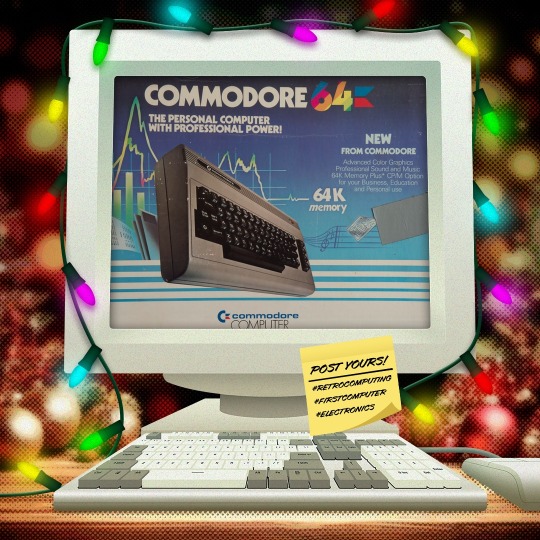
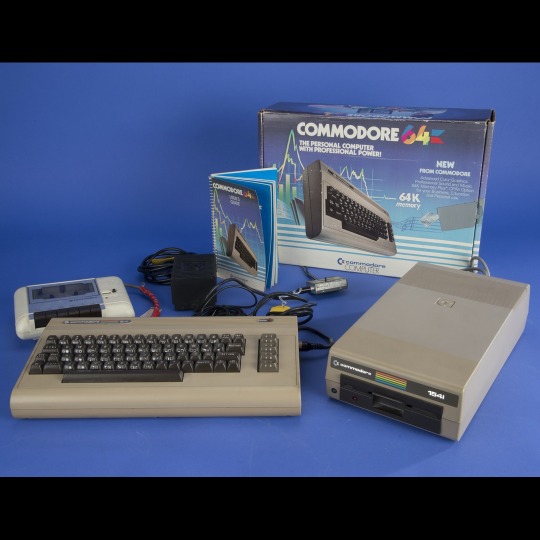
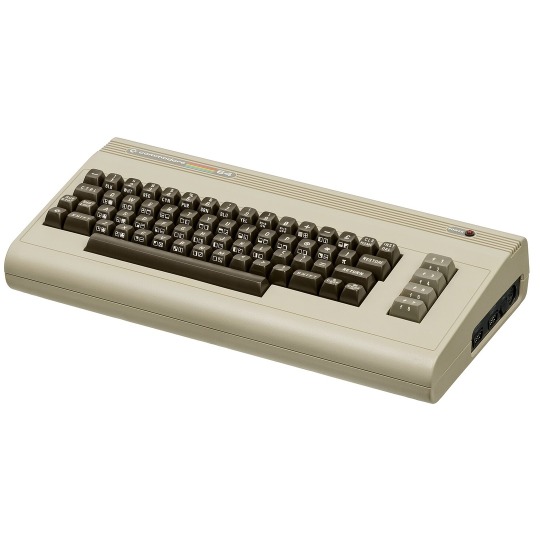
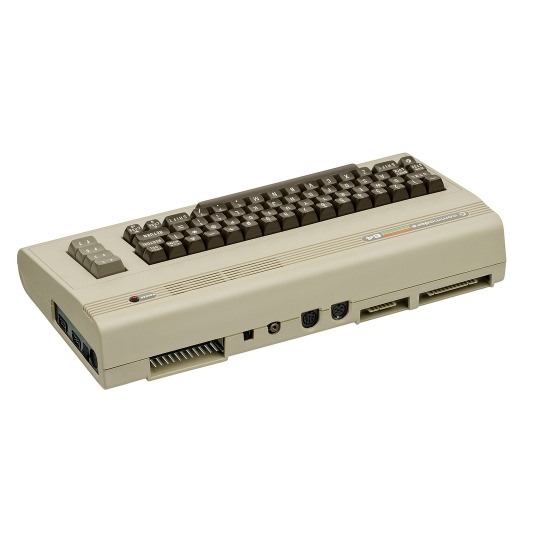
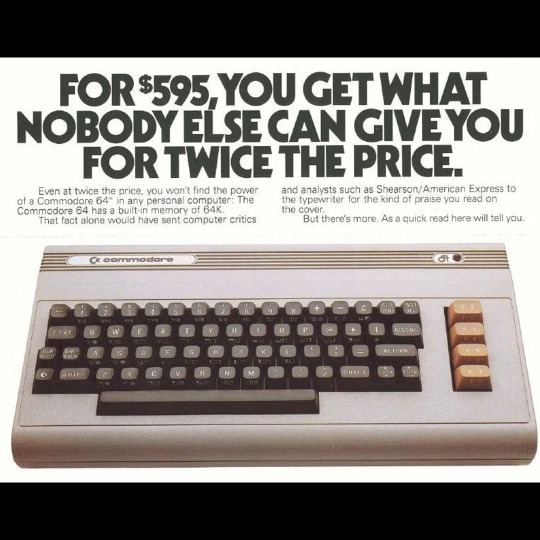
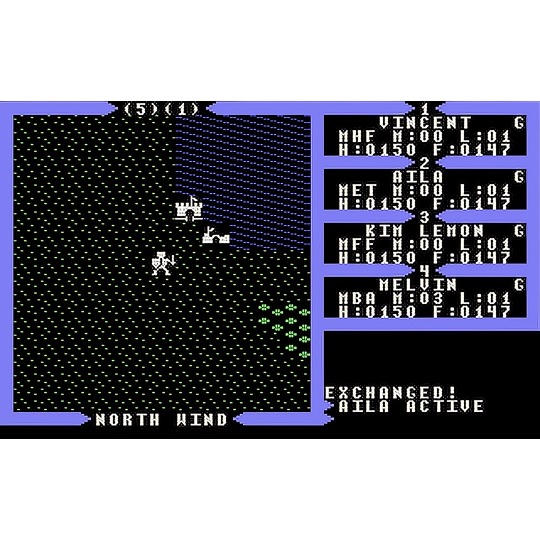
🎄💾🗓️ Day 18: Retrocomputing Advent Calendar - Commodore 64🎄💾🗓️
The Commodore 64, released in 1982, is one of the ones we keep hearing got many people their start in their own computing history. Powered by a MOS Technology 6510 processor at 1.02 MHz and featuring 64 KB of RAM, it became the best-selling single computer model of all time, with an estimated 12.5–17 million units sold. Its graphics were driven by the VIC-II chip, capable of 16 colors, hardware sprites, and smooth scrolling, while the SID (Sound Interface Device) chip delivered advanced audio, supporting three voices with waveforms and filters, making it a lot of fun for gaming and music.
Featured a built-in BASIC interpreter, allowing users to write their own programs out-of-the-box. The C64’s affordability, large software library, lots of games, productivity, and educational applications made it a household name. It connected to TVs as monitors and supported peripherals like the 1541 floppy disk drive, datasette, and various joysticks. With over 10,000 commercial software titles and a thriving homebrew scene, the C64 helped define a generation of computer enthusiasts.
Its impact on gaming was gigantic, iconic titles like The Last Ninja, Maniac Mansion, and Impossible Mission. The C64 also inspired a demoscene, where programmers pushed its hardware for visual and audio effects. The Commodore 64 remains a symbol of computing for the masses and creative innovation, still loved by retrocomputing fans today.
Check out the National Museum of American History, and Wikipedia. https://americanhistory.si.edu/collections/object/nmah_334636 https://en.wikipedia.org/wiki/Commodore_64
And…! An excellent story from Jepler -
== While I started on the VIC 20, the Commodore 64 was my computer for a lot longer. Its SID sound chip was a headline feature, and many of my memories of it center around music. Starting with Ultima III, each game in the series had a different soundtrack for each environment (though each one was on a pretty short loop, it probably drove my folks nuts when I would play for hours). There were music editors floating around, so I tried my hand at arranging music for its 3 independent voices, though I can't say I was any good or that I have any of the music now. You could also download "SID tunes" on the local BBSes, where people with hopefully a bit more skill had arranged everything from classical to Beatles to 80s music.
Folks are still creating cool new music on the Commodore 64. One current creator that I like a great deal is Linus Åkesson. Two videos from 2024 using the Commodore 64 that really impressed me were were a "Making 8-bit Music From Scratch at the Commodore 64 BASIC Prompt", a live coding session (http://www.linusakesson.net/programming/music-from-scratch/index.php) and Bach Forever (http://www.linusakesson.net/scene/bach-forever/index.php) a piece played by Åkesson on two Commodore 64s.
Like so many things, you can also recreate the experience online. Here's the overworld music for Ultima III: https://deepsid.chordian.net/?file=/MUSICIANS/A/Arnold_Kenneth/Ultima_III-Exodus.sid&subtune=1 -- the site has hundreds or thousands of other SIDs available to play right in the browser.
Have first computer memories? Post’em up in the comments, or post yours on socialz’ and tag them #firstcomputer #retrocomputing – See you back here tomorrow!
#commodore64#retrocomputing#vintagecomputing#computermuseum#classicgames#retrogaming#1980snostalgia#mos6510#vicii#sidchip#gaminghistory#computerhistory#personalcomputing#programming#8bitgaming#demoscene#computerscience#classiccomputers#homecomputing#nostalgiamachine#oldschoolgaming#historicaltech#technostalgia#c64games#gaminglegends#codinghistory#earlycomputers#floppydisk#techmuseum#retrotech
82 notes
·
View notes
Text

#Tech#Computer#RetroTech#Retro#RetroTechnology#RetroComputers#VintageComputer#RetroComputing#Magazine#VintageAd#VintageTech#ComputerHistory
215 notes
·
View notes
Note
Does your 1219 have a nickname?
Also, I was wondering if you have any fun stories surrounding it! Strange quirks it has or anything like that.
I'd love to see more photos if you're allowed to post them!
Thanks for the question! These are my favorite part about my blog by far.
Not exactly, the UNIVAC 1219 doesn’t have a nickname. I did realize recently that I should specify the pronunciation (Twelve-Nineteen), but it doesn’t have any nicknames. Apart from ‘the 1219’, it’s also regularly referred to as the CPU or just ‘the computer’.
Fun stories or weird quirks? Boy, I could fill a book with this machine’s weird quirks (or as we say, intermittent issues), but I’ll try to blitz through the most common ones:
Sometimes the computer will stop running and enter a WAIT mode. No reason, it just needs a break. We can’t fix it, it just has to decide to go back into operating mode.
The computer will often start attempting to communicate on IO channel 13. We’re not telling it to talk to anything, it just decides to try to.
One of our teletypes (the Kleinshmidt) stamps ink splotches into the paper rather than characters most of the time. However, this weekend it worked for the first time in 10 months! We didn’t change anything, it just had an extra cup of coffee or something.
The Digital Data Recorder, or the tape drive, has the most gremlins out of any of our units. The top handler works fairly well, but the bottom handler won’t properly read data, write data, move the tape forward, initialize the tape, or any number of other issues.
There’s more but hopefully this satisfies your curiosity.
Fun stories? Well, I can’t name any specific ones, but I can say it’s a very endearing machine. It’s the very last of its kind and being one of three individuals in the world responsible for it makes every issue that more frustrating. There is no real forum for it, the subject matter experts sit next to me and are often just as exasperated as I am.
But the unique nature of this situation make every successful diagnostic test that much sweeter. Every new addition (5.25” floppy drive via serial) that much cooler. I have an IBM PC-XT clone at home, but I thank my lucky stars every day that this big iron is what I get to specialize in.
As for more photos, I have none that are as grandiose as you would probably expect. I do have my working photos though. I took all my photos when I first started working on it and now I am more dedicated to fixes than photo-ops.

This is a photo of our finicky Kleinshmidt teletype. Still has blotches but it actually printed!

This is the back of the bottom handler. Pictured is the vacuum pump in the bottom left (so sudden stops just yank magnetic tape slack rather than ripping tape). The big cylinder in the center is a motor for running the magnetic tape handler itself. The big black ‘hose’ of wires coming out of the steel plate contains all the cables that come right off the handler’s head for reading and writing data!
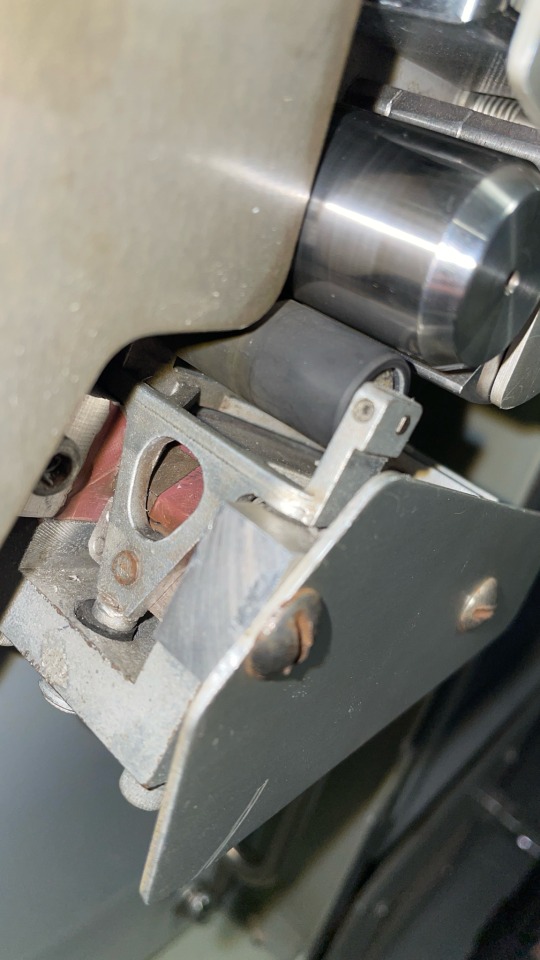
This is the forward pinch roller of the bottom handler. It was replaced after this photo was taken as you can see the rubber has deteriorated in the 55 years this machine has been operating.
As for being allowed to post photos, that’s not an issue. The last 1219 was decommissioned in 2014 and now you can find all of its documentation online at http://www.bitsavers.org/pdf/univac/military/1219/
#vintagecomputing#mainframe#antiquetech#digitalarchaeology#navy#new jersey#oldtechnology#retrotech#tech#univac#new blog#computerarchaeology#computerhistory#old technology#old computers#vintagehardware#classiccomputing#technology#retro tech#big iron#computer
64 notes
·
View notes
Text
When Andrew Bailey's Brain Machine is Operating at the Victoria Fringe Festival 2024, Not Everything is Meant to Compute!
Andrew Bailey of Atomic Vaudeville fame has a one man show at @IntrepidTheatre #yyjfringe, and while Brain Machine is hard to classify, it's ultimately a #standup #comedy about facing those challenges life throws at you, #computerhistory
Anyone not familiar with Andrew Bailey‘s work may find Brain Machine disjointed and seemingly randomly transitioning from one story to another. It’s like those monologues one sees on a late night talk show, where the host can talk about anything, and audiences will laugh. Although I stopped watching these types of shows when Arsenio Hall’s show went off the air, this spoken word comedy caught my…

View On WordPress
0 notes
Text

"Debugging" - Error Free Application Development by AppCurators
Did you know? The term 'debugging' was coined in the 1940s when engineers literally removed insects from early computer systems. Talk about literal problem-solving!
#TechHistory #ProgrammingFacts #Debugging #SoftwareEngineering #ComputerHistory #CodingTrivia #InnovationHistory #FunTechFacts #BugFixing #EngineeringOrigins #AppCurators
#mobile app development#mobile app development agency#mobile app development company#mobile application development services#mobile application services
0 notes